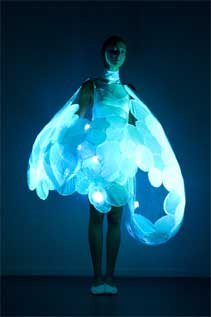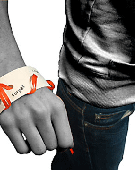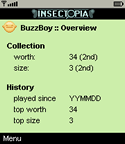Sep 30, 2006
Gaming Realities
|
|
What role do videogames play in our lives today? As the boundaries between the virtual and the real blur more and more in the new gaming worlds we have come to inhabit, new conditions arise.
With the theme Gaming Realities, medi@terra 06 aims to explore the different dimensions and developments in the gaming fields and the impact they have on the different fields of society today. This year's Festival and International Conference set up to explore the diverse ideas, narratives, and ideologies involved in the video games.
Videogames express and reflect today's world, its aesthetics and technologies, give rise to new identities and new mentalities. Medi@terra Festival has invited individuals who have realised the importance and dimensions which this field has acquired, asking them to deposit their viewpoints and experiences with regard to the connections of the game to society, the identity and psychology of the player, the space and narration of the game, new technologies and conceptions and possibilities for the computer game to comprise the key art of 21st century.
'Gaming Realities: the Challenge of Digital Culture' is a three days International Conference [6-8 October, Athens] organised by Fournos Centre for the Digital Culture.
19:43 Posted in Positive Technology events, Serious games | Permalink | Comments (0) | Tags: serious gaming
Perimeters, Boundaries, and Borders
|
Artists, architects, designers, and other practitioners are constantly fashioning new forms and challenging disciplinary boundaries as they employ techniques such as rapid prototyping and generative processes. In the exhibition Perimeters, Boundaries, and Borders, at Lancaster, UK's Citylab, organizers Fast-uk and Folly explore the range of objects, buildings, and products being conceptualized with the aid of digital technologies. Aoife Ludlow's 'Remember to Forget?' is a series of jewelry designs that envisioned accessories incorporating RFID tags that allow the wearer to record information and emotions associated with those special items that we put on daily. Tavs Jorgensen uses a data glove in his 'Motion in Form' project. After gesturing around an object, data collected by the glove is given physical shape using CNC (Computer Numerical Control) milling, creating representations of the movements in materials such as glass or ceramics. Addressing traces of a different sort is Cylcone.soc, a data mapping piece by Gavin Bailey and Tom Corby. These works and many more examples from the frontiers of art and design are on view until October 21st." Rhizome News. |
19:39 Posted in Emotional computing, Pervasive computing | Permalink | Comments (0) | Tags: ambient intelligence, emotional computing, pervasive technology, persuasive technology
Increasing cortical activity in auditory areas through neurofeedback fMRI
Increasing cortical activity in auditory areas through neurofeedback functional magnetic resonance imaging.
Neuroreport. 2006 Aug 21;17(12):1273-8
Authors: Yoo SS, O'Leary HM, Fairneny T, Chen NK, Panych LP, Park H, Jolesz FA
We report a functional magnetic resonance imaging method to deliver task-specific brain activities as biofeedback signals to guide individuals to increase cortical activity in auditory areas during sound stimulation. A total of 11 study participants underwent multiple functional magnetic resonance imaging scan sessions, while the changes in the activated cortical volume within the primary and secondary auditory areas were fed back to them between scan sessions. On the basis of the feedback information, participants attempted to increase the number of significant voxels during the subsequent trial sessions by adjusting their level of attention to the auditory stimuli. Results showed that the group of individuals who received the feedback were able to increase the activation volume and blood oxygenation level-dependent signal to a greater degree than the control group.
19:27 Posted in Biofeedback & neurofeedback | Permalink | Comments (0) | Tags: neurofeedback
Endoscopic eye tracking system for fMRI
Endoscopic eye tracking system for fMRI.
J Neurosci Methods. 2006 Sep 13;
Authors: Kanowski M, Rieger JW, Noesselt T, Tempelmann C, Hinrichs H
Here we introduce a new video-based real-time eye tracking system suitable for functional magnetic resonance imaging (fMRI) application. The described system monitors the subject's eye, which is illuminated with infrared light, directly at the headcoil using an endoscopic fibre optical system. This endoscopic technique assures reliable, easy-to-use and fast adjustment. It requires only a minimal amount of equipment at the headcoil and inside the examination room. Moreover, the short distance between the image acquisition optics and the eye provides high spatial tracking resolution. Interference from physiological head movement is effectively reduced by simultaneous tracking of both eye and head movements.
19:25 Posted in Neurotechnology & neuroinformatics, Research tools | Permalink | Comments (0) | Tags: neuroinformatics, eye-tracking
Utilizing Gamma Band to Improve Mental Task Based Brain-Computer Interface Design
Utilizing Gamma Band to Improve Mental Task Based Brain-Computer Interface Design
IEEE Transactions on Neural Systems and Rehabilitation Engineering, Volume 14, Issue 3, Sept. 2006 Page(s): 299 - 303
Palaniappan, R.
A common method for designing brain–computer Interface (BCI) is to use electroencephalogram (EEG) signals extracted during mental tasks. In these BCI designs, features from EEG such as power and asymmetry ratios from delta, theta, alpha, and beta bands have been used in classifying different mental tasks. In this paper, the performance of the mental task based BCI design is improved by using spectral power and asymmetry ratios from gamma (24–37 Hz) band in addition to the lower frequency bands. In the experimental study, EEG signals extracted during five mental tasks from four subjects were used. Elman neural network (ENN) trained by the resilient backpropagation algorithm was used to classify the power and asymmetry ratios from EEG into different combinations of two mental tasks. The results indicated that 1) the classification performance and training time of the BCI design were improved through the use of additional gamma band features; 2) classification performances were nearly invariant to the number of ENN hidden units or feature extraction method.
19:24 Posted in Neurotechnology & neuroinformatics | Permalink | Comments (0) | Tags: brain-computer interface
Brain-computer interfaces for control of neuroprostheses
Brain-computer interfaces for control of neuroprostheses: from synchronous to asynchronous mode of operation.
Biomed Tech (Berl). 2006;51(2):57-63
Authors: Müller-Putz GR, Scherer R, Pfurtscheller G, Rupp R
Transferring a brain-computer interface (BCI) from the laboratory environment into real world applications is directly related to the problem of identifying user intentions from brain signals without any additional information in real time. From the perspective of signal processing, the BCI has to have an uncued or asynchronous design. Based on the results of two clinical applications, where 'thought' control of neuroprostheses based on movement imagery in tetraplegic patients with a high spinal cord injury has been established, the general steps from a synchronous or cue-guided BCI to an internally driven asynchronous brain-switch are discussed. The future potential of BCI methods for various control purposes, especially for functional rehabilitation of tetraplegics using neuroprosthetics, is outlined.
19:21 Posted in Brain-computer interface, Neurotechnology & neuroinformatics | Permalink | Comments (0) | Tags: brain-computer interface
Beyond emoticons
Anthony Boucouvalas and colleagues at Bournemouth University in the UK have created a system that contorts an image of a user's face to express different emotions, New Scientist reports. According to Boucouvalas and coll., the system might be used to enrich text-based internet chat.
From the article:
A user first uploads a picture of their face with a "neutral" expression. Then they use their mouse to mark the ends of their eyebrows, the corners of their mouth and the edges of their eyes and lips. The software uses these points to morph the face to express different emotions: happiness, sadness, fear, anger, surprise, and disgust. A user can select an emotion and one of three intensity levels when using the system.
Read the full story here
See also Illustrations from Smiley Arena
19:05 Posted in Emotional computing | Permalink | Comments (0) | Tags: affective computing
Sep 27, 2006
M300: wristwatch GSM phone with SMS
Via Textually.org

The Australian company SMS Development has announced the world's first truly mobile GSM watch phone.
The watchphone has SMS capabilities with an internal antenna, is tri-band and comes with bluetooth functionality; talk time is 80 minutes.
20:15 Posted in Wearable & mobile | Permalink | Comments (0) | Tags: wereable, mobile
Frequency of stuttering during virtual reality job interviews
Frequency of stuttering during challenging and supportive virtual reality job interviews.
J Fluency Disord. 2006 Sep 23;
Authors: Brundage SB, Graap K, Gibbons KF, Ferrer M, Brooks J
This paper seeks to demonstrate the possibility of manipulating the frequency of stuttering using virtual reality environments (VREs). If stuttering manifests itself in VREs similarly to the way it manifests itself in real world interactions, then VREs can provide a controlled, safe, and confidential method for treatment practice and generalization. Though many researchers and clinicians recognize the need for generalization activities in the treatment of stuttering, achieving generalization in a clinical setting poses challenges to client confidentiality, safety, and the efficient use of a professionals' time. Virtual reality (VR) technology may allow professionals the opportunity to enhance and assess treatment generalization while protecting the safety and confidentiality of their clients. In this study, we developed a VR job interview environment which allowed experimental control over communication style and gender of interviewers. In this first trial, persons who stutter (PWS) experienced both challenging and supportive VR job interview conditions. The percentage of stuttered syllables was calculated for both interviews for each participant. Self-reported ratings of communication apprehension and confidence were also obtained, and were not significantly correlated with stuttering severity. Results indicated that interviewer communication style affected the amount of stuttering produced by participants, with more stuttering observed during challenging virtual interviews. Additionally, the amount of stuttering observed during the VR job interviews was significantly, positively correlated with the amount of stuttering observed during an interview with the investigator prior to VR exposure. Participants' subjective reports of the VR experience indicate reactions similar to those they report experiencing in the real world. Possible implications for the use of VR in the assessment and treatment of stuttering are discussed. Educational objectives: After reading this article, the reader will be able to-(1) list some of the challenges to treatment generalization; (2) describe how virtual reality technology can assist in alleviating some of these challenges; (3) describe how the frequency of stuttering varies across two different virtual environments.
20:03 Posted in Cybertherapy, Virtual worlds | Permalink | Comments (0) | Tags: virtual reality, cybertherapy
Allen Brain Atlas
Read the full story
08:21 Posted in Neurotechnology & neuroinformatics | Permalink | Comments (0) | Tags: neuroinformatics
Sep 26, 2006
Gametrack: a new device for virtual rehabilitation?


15:00 Posted in Cybertherapy, Serious games, Virtual worlds | Permalink | Comments (0) | Tags: virtual reality, cybertherapy, serious gaming
Sep 24, 2006
Behaviour & Information Technology 25th Anniversary Conference
Via Usability News
Event Date: 10 October 2006 to 10 October 2006
Behaviour & Information Technology 25th Anniversary Conference
An essential one-day conference with pre-event workshop examining 25 years of usable technology design and current concerns and challenges for usability experts worldwide
10th October 2006, The Grange City Hotel, London
This conference will provide a unique insight into the state of the art of usability design and will review the progress that has been made over the past 25 years in designing usable technology. It will highlight lessons for designers of today’s technology including web sites, games, mobile phones, kiosks, iTV and hand-held devices.
For more information visit www.tandfevents.com/bit
22:57 Posted in Positive Technology events | Permalink | Comments (0) | Tags: human-computer interaction
The Four Pleasures: Usability and Beyond - Cambridge, UK
Via Usability News
Event Date: 11 September 2006 to 11 September 2006
Patrick Jordan will describe a framework for describing people holistically called 'The Four Pleasures'.
Date: Monday 11th September
Time: 6.30 for 6.45
Venue: Microsoft Research, Cambridge
Cost: The event is FREE and you do not need to be a UK UPA member to attend
Registration: Please email cambridge.usability@gmail.com to reserve a place.
Location map and directions: www.research.microsoft.com/aboutmsr/visitmsr/cambridge
An overview:
Products and services should bring pleasure to those who use them and profit to those who create them. To do this effectively they must connect with the consumer in a compelling manner. Effective innovation means designing products that meet both our practical and emotional needs. It speaks to our personalities and values — our hopes, fears, dreams and aspirations. If we are to connect fully with consumers then we have to fully understand them. Having a deep and thorough understanding of people is the key to designing the products and services that people will want to buy and that they will find useful and enjoyable.
This presentation outlines a framework for understanding people holistically. It is called ‘The Four Pleasures’.
This framework has been applied to the design and marketing of many of the world’s most successful products and services across all market types and sectors. It is used by many of the world’s leading brands including: Microsoft, Starbucks, Ford, Nokia, Gillette and Proctor and Gamble.
The ‘four pleasures’ divides human experience and motivation into the following four areas.
Physio-Pleasure: This is to do with the body - pleasures derived from the senses. In the context of products physio-pleasure would cover, for example, tactile and olfactory properties as well as ergonomic issues.
Socio-Pleasure: This is the enjoyment derived from relationships with others. Products and services may help to enhance or facilitate particular social situations and may confer social or cultural status on the user.
Psycho-Pleasure: This type of pleasure refers to people’s cognitive and emotional reactions, including their reactions to the products and services that they use.
Ideo-Pleasure: This concerns people’s values. It is important that the values embodied in products and services are consistent with the values of those for whom they have been designed.
The presentation will be illustrated with many examples of products and services that have been designed using this framework. These have proved to be extremely successful commercially as well as a huge hit with users. By understanding people holistically and designing to meet their needs we can create products and services which will have a significant and positive affect on both individuals and society as a whole. They will be a joy to use and will bring success to those who manufacture and supply them.
22:55 Posted in Positive Technology events | Permalink | Comments (0) | Tags: experience design
SmartRetina used as a navigating tool in Google earth
Via Nastypixel
SmartRetina is a system that allows to capture the user’s hand gestures and recognize them as computer actions.
22:51 Posted in Future interfaces | Permalink | Comments (0) | Tags: future interfaces
Context-Aware Gaming
|
insectopia is a new kind of cell phone game where the real world spills into the game world. Players roam the cityscape searching for and catching a multitude of different insects. Each insects in the game world is generated by using the available bluetooth devices available in the player's vicinity. By catching insects and trading them with other players, players build their own collection bigger and better. The current status of the game is displayed on various highscore lists both in the phones and online. See also geoquiz, a location-based mobile game in which players create and answer questions related to their current geographic position (kept track of through the GSM network). |
21:58 Posted in Pervasive computing | Permalink | Comments (0) | Tags: context-aware gaming
Is social networking changing the way people relate to each other?
New Scientist has an interview with sociologist and MIT professor Sherry Turkle about how "always-on" communication devices - i.e. instant messaging, Wi-Fi and cellphones - are changing the way people relate to each other.
Here is an excerpt from the article:
For some people, things move from "I have a feeling, I want to call a friend" to "I want to feel something, I need to make a call". In either case, what is not being cultivated is the ability to be alone and to manage and contain one's emotions. When technology brings us to the point where we're used to sharing our thoughts and feelings instantaneously, it can lead to a new dependence, sometimes to the extent that we need others in order to feel our feelings in the first place.
Our new intimacies with our machines create a world where it makes sense to speak of a new state of the self. When someone says "I am on my cell", "online", "on instant messaging" or "on the web", these phrases suggest a new placement of the subject, a subject wired into social existence through technology, a tethered self. I think of tethering as the way we connect to always-on communication devices and to the people and things we reach through them.
Continue to read the full interview
21:30 Posted in Persuasive technology, Pervasive computing | Permalink | Comments (0) | Tags: pervasive technology
Sep 21, 2006
OpenStim: The Open Noninvasive Brain Stimulator
Via The Neurodudes
The goal of the project "OpenStim" is to design a simple, safe, effective transcranial magnetic stimulation (TMS) for modulation of emotion, sleep, attention, and other central nervous system properties. TMS system price often exceeds $50.000. The project's team aims to develop a TMS device that will be constructable by a practitioner skilled in electrical engineering, for less than $400.
Also, all the knowledge generated by the project is released under the Creative Commons “Attribution and Sharealike” license. This is a new model for “open source” medical device development — which may move it beyond the domain of simply creating “cool toys,” and to creating real devices.
From the OpenStim website:
The project comprises at least the following 8 components. The logical way to begin is to A) figure out the field geometry desired at the specific depth under the skull, B) design a prototype coil, preferably with standardized values, C) pick the capacitor and resistor adjoining, D) work your way back to the power supply. 1. a reinforced coil (e.g., of copper wire) geometrically appropriate for stimulating the brain (e.g., a figure-8 coil, containing two circular loops, between 3 and 7 cm in diameter),
1b. a testing tank which would hold saline, to mimic the volume conductor of the brain, and thereby permit the electric field to be mapped for various coils and pulse protocols,
2. the control circuitry for charging up a high-capacity capacitor or bank of capacitors, via a power supply
3. mechanical hardware for holding and positioning the coil with respect to the head,
4. safety circuitry that limits the current discharged and the repetition rate of the stimulator,
5. an optional measurement device (e.g., fluxgate magnetometer) to measure the magnetic field induced, and
6. computer software and interface hardware for connecting a computer to the control circuitry, and for displaying hardware status and/or error events.
7. integration with EEG or IR was brought up by many attendees of the session at Foo Camp. The contributors decided this should be built in, a priori.
8. OTHER THOUGHT: transcranial direct current stimulation (tDCS) has, like TMS, been shown to improve working memory and mood. Shall we design our TMS device with the capability of doing simultaneous tDCS? It could complicate things somewhat. Hoewver, the methodology is dead simple — apply a DC current across two electrodes, attached to the scalp! system connected to an AC wall source or battery source, and then controlling the discharge of the capacitor into the coil,
20:07 Posted in Neurotechnology & neuroinformatics | Permalink | Comments (0) | Tags: transcranial magnetic stimulation
Electrical stimulation of the brain can create the sensation of a "shadow person"
Via KurzweilAI.net
Olaf Blanke and colleagues at the Federal Polytechnic School of Lausanne have found electrical stimulation of the brain can create the sensation of a "shadow person" mimicking one's bodily movements.
During a neurological assessment of a woman, doctors stimulated the left temporoparietal junction area of the brain. This stimulation caused her to believe a person was standing behind her. The patient reported that "person" adopted the same bodily positions as her, although she didn't recognize the effect as an illusion.
The discovery, reported in this week's issue of the journal Nature, might foster the understanding of psychiatric phenomena such as feelings of paranoia, persecution and alien control, Swiss researchers say.
19:57 Posted in Neurotechnology & neuroinformatics | Permalink | Comments (0) | Tags: brain stimulation
Follow-up study of learning-disabled children treated with neurofeedback or placebo
Follow-up study of learning-disabled children treated with neurofeedback or placebo.
Clin EEG Neurosci. 2006 Jul;37(3):198-203
Authors: Becerra J, Fernández T, Harmony T, Caballero MI, García F, Fernández-Bouzas A, Santiago-Rodríguez E, Prado-Alcalá RA
This report is a 2-year follow-up to a previous study describing positive behavioral changes and a spurt of EEG maturation with theta/alpha neurofeedback (NFB) training in a group of Learning Disabled (LD) children. In a control paired group, treated with placebo, behavioral changes were not observed and the smaller maturational EEG changes observed were easily explained by increased age. Two years later, the EEG maturational lag in Control Group children increased, reaching abnormally high theta Relative Power values; the absence of positive behavioral changes continued and the neurological diagnosis remained LD. In contrast, after 2 years EEG maturation did continue in children who belonged to the Experimental Group with previous neurofeedback training; this was accompanied by positive behavioral changes, which were reflected in remission of LD symptoms.
19:33 Posted in Biofeedback & neurofeedback | Permalink | Comments (0) | Tags: neurofeedback
E-garments
Via WMMNA
Philips Design has prototyped two garments that demonstrate how electronics can be incorporated into fabrics and clothes to express the emotions and personality of the wearer.
Bubelle, the "blushing dress" comprises two layers, the inner one is equipped with sensors that respond to changes in the wearer's emotions and projects them onto the outer textile. It behaves differently depending on who is wearing it. The other prototype is Frison, a body suit that reacts to being blown on by igniting a private constellation of tiny LEDs. Both measure skin signals and change light emission through biometric sensing technology.


Design Probe is an in-house far-future research program that considers what lifestyles might be like in 2020.The SKIN probe project is part of the program and challenges the notion that our lives are automatically better because they are more digital. It looks at more 'analog' phenomena like emotional sensing, exploring technologies that are 'sensitive' rather than 'intelligent'. Two outfits have been developed as part of SKIN to identify a new way of communicating with those around us by using garments as proxies to convey deep feelings that are difficult to express in words.
The Bubelle - Blush Dress comprises two layers, the inner layer of which is equipped with sensors that respond to changes in the wearer's emotions and projects them onto the outer textile. The body suit Frisson has LEDs that illuminate according to the wearer's state of excitement. Both measure skin signals and change light emission through biometric sensing technology.
Download images here
Read the full press release
10:35 Posted in Emotional computing, Wearable & mobile | Permalink | Comments (0) | Tags: emotional computing, wearable









